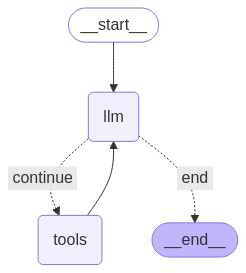LangGraph 是用於建構具狀態的 LLM 應用程式架構,因此是建構 ReAct (Reasoning and Acting) 代理程式的理想選擇。
ReAct 代理程式會結合 LLM 推理與動作執行。他們會反覆思考、使用工具,並根據觀察結果採取行動,以達成使用者目標,並動態調整方法。此模式在 「ReAct:在語言模型中整合推理和行動」 (2023) 中推出,試圖模仿人類在僵硬的工作流程中,以靈活的方式解決問題。
雖然 LangGraph 提供預先建構的 ReAct 代理程式 (create_react_agent),但如果您需要對 ReAct 導入作業進行更多控管和自訂,LangGraph 就會發揮作用。
LangGraph 會使用三個主要元件,將代理程式建模為圖表:
State:代表應用程式目前快照的共用資料結構 (通常為TypedDict或Pydantic BaseModel)。Nodes:為您的代理程式編碼邏輯。這些函式會以輸入內容的形式接收目前的狀態,執行某些運算或附帶效果,並傳回更新後的狀態,例如 LLM 呼叫或工具呼叫。Edges:根據目前的State定義下一個要執行的Node,允許使用條件式邏輯和固定轉換。
如果您尚未取得 API 金鑰,可以前往 Google AI Studio 免費取得。
pip install langgraph langchain-google-genai geopy requests
在環境變數 GEMINI_API_KEY 中設定 API 金鑰。
import os
# Read your API key from the environment variable or set it manually
api_key = os.getenv("GEMINI_API_KEY")
為了進一步瞭解如何使用 LangGraph 實作 ReAct 代理程式,我們將逐步示範實際範例。您將建立一個簡單的智慧代理程式,其目標是使用工具查詢指定位置目前的天氣。
對於這個天氣服務機器人,其 State 需要保留目前的對話記錄 (以訊息清單形式呈現),以及步驟數量的計數器,以便進一步說明狀態管理。
LangGraph 提供方便的輔助程式 add_messages,可用於更新狀態中的訊息清單。這個函式可做為縮減器,也就是說,它會取得目前的清單和新訊息,然後傳回合併的清單。這項功能會根據郵件 ID 聰明地處理更新作業,並預設為針對新的專屬郵件採用「僅附加」行為。
from typing import Annotated,Sequence, TypedDict
from langchain_core.messages import BaseMessage
from langgraph.graph.message import add_messages # helper function to add messages to the state
class AgentState(TypedDict):
"""The state of the agent."""
messages: Annotated[Sequence[BaseMessage], add_messages]
number_of_steps: int
接下來,您要定義天氣工具。
from langchain_core.tools import tool
from geopy.geocoders import Nominatim
from pydantic import BaseModel, Field
import requests
geolocator = Nominatim(user_agent="weather-app")
class SearchInput(BaseModel):
location:str = Field(description="The city and state, e.g., San Francisco")
date:str = Field(description="the forecasting date for when to get the weather format (yyyy-mm-dd)")
@tool("get_weather_forecast", args_schema=SearchInput, return_direct=True)
def get_weather_forecast(location: str, date: str):
"""Retrieves the weather using Open-Meteo API for a given location (city) and a date (yyyy-mm-dd). Returns a list dictionary with the time and temperature for each hour."""
location = geolocator.geocode(location)
if location:
try:
response = requests.get(f"https://api.open-meteo.com/v1/forecast?latitude={location.latitude}&longitude={location.longitude}&hourly=temperature_2m&start_date={date}&end_date={date}")
data = response.json()
return {time: temp for time, temp in zip(data["hourly"]["time"], data["hourly"]["temperature_2m"])}
except Exception as e:
return {"error": str(e)}
else:
return {"error": "Location not found"}
tools = [get_weather_forecast]
接下來,您需要初始化模型,並將工具繫結至模型。
from datetime import datetime
from langchain_google_genai import ChatGoogleGenerativeAI
# Create LLM class
llm = ChatGoogleGenerativeAI(
model= "gemini-2.5-pro",
temperature=1.0,
max_retries=2,
google_api_key=api_key,
)
# Bind tools to the model
model = llm.bind_tools([get_weather_forecast])
# Test the model with tools
res=model.invoke(f"What is the weather in Berlin on {datetime.today()}?")
print(res)
在執行代理程式之前,您必須定義節點和邊。在本例中,您有兩個節點和一個邊緣。- 執行工具方法的 call_tool 節點。LangGraph 有一個預先建構的節點,稱為 ToolNode。- 使用 model_with_tools 呼叫模型的 call_model 節點。- 決定是否要呼叫工具或模型的 should_continue 邊緣。
節點和邊的數量並未固定。您可以視需要在圖表中新增任意數量的節點和邊。舉例來說,您可以新增節點來新增結構化輸出內容,或是新增自檢查/反射節點,以便在呼叫工具或模型前檢查模型輸出內容。
from langchain_core.messages import ToolMessage
from langchain_core.runnables import RunnableConfig
tools_by_name = {tool.name: tool for tool in tools}
# Define our tool node
def call_tool(state: AgentState):
outputs = []
# Iterate over the tool calls in the last message
for tool_call in state["messages"][-1].tool_calls:
# Get the tool by name
tool_result = tools_by_name[tool_call["name"]].invoke(tool_call["args"])
outputs.append(
ToolMessage(
content=tool_result,
name=tool_call["name"],
tool_call_id=tool_call["id"],
)
)
return {"messages": outputs}
def call_model(
state: AgentState,
config: RunnableConfig,
):
# Invoke the model with the system prompt and the messages
response = model.invoke(state["messages"], config)
# We return a list, because this will get added to the existing messages state using the add_messages reducer
return {"messages": [response]}
# Define the conditional edge that determines whether to continue or not
def should_continue(state: AgentState):
messages = state["messages"]
# If the last message is not a tool call, then we finish
if not messages[-1].tool_calls:
return "end"
# default to continue
return "continue"
您現在已備妥建構代理程式所需的所有元件。讓我們將這些內容整合起來。
from langgraph.graph import StateGraph, END
# Define a new graph with our state
workflow = StateGraph(AgentState)
# 1. Add our nodes
workflow.add_node("llm", call_model)
workflow.add_node("tools", call_tool)
# 2. Set the entrypoint as `agent`, this is the first node called
workflow.set_entry_point("llm")
# 3. Add a conditional edge after the `llm` node is called.
workflow.add_conditional_edges(
# Edge is used after the `llm` node is called.
"llm",
# The function that will determine which node is called next.
should_continue,
# Mapping for where to go next, keys are strings from the function return, and the values are other nodes.
# END is a special node marking that the graph is finish.
{
# If `tools`, then we call the tool node.
"continue": "tools",
# Otherwise we finish.
"end": END,
},
)
# 4. Add a normal edge after `tools` is called, `llm` node is called next.
workflow.add_edge("tools", "llm")
# Now we can compile and visualize our graph
graph = workflow.compile()
您可以使用 draw_mermaid_png 方法將圖表視覺化。
from IPython.display import Image, display
display(Image(graph.get_graph().draw_mermaid_png()))

現在,讓我們執行代理程式。
from datetime import datetime
# Create our initial message dictionary
inputs = {"messages": [("user", f"What is the weather in Berlin on {datetime.today()}?")]}
# call our graph with streaming to see the steps
for state in graph.stream(inputs, stream_mode="values"):
last_message = state["messages"][-1]
last_message.pretty_print()
你現在可以繼續對話,例如詢問其他城市的天氣或比較天氣。
state["messages"].append(("user", "Would it be in Munich warmer?"))
for state in graph.stream(state, stream_mode="values"):
last_message = state["messages"][-1]
last_message.pretty_print()

